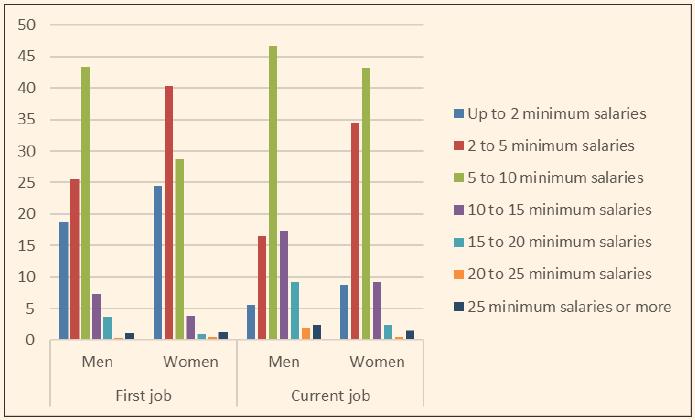Acloser look at Brazil’s labor market over the last several decades reveals consistent structural transformations that accelerated in the 1990s. Its last growth cycle, which began in 2003 and lasted slightly more than ten years, significantly increased social inclusion opportunities by way of the market and expanded protection institutes associated to work and unemployment. This occurred simultaneously with the offer of better access to all levels of education. Primary school became universal, access to secondary school increased significantly, and especially important was the greater number of openings available at private and government-supported higher education institutions.
Something notably new was the generalization of affirmative policy initiatives for higher education with the goal of benefitting groups that had previously been minorities in higher education institutions. Nevertheless, these improved opportunities came hand-in-hand with a persistent segmentation in institutions and degree programs that became increasingly disparate in terms of their quality, thus conferring titles that garnered unequal market values. (BRITO, 2014; COSTA RIBEIRO; SCHLEGEL, 2015; COSTA RIBEIRO; CENEVIVA; BRITO, 2015).
Furthermore, the labor market recuperation that Brazil experienced until 2014 occurred together with the challenges related to fomenting economic inclusion for young people in transition to adulthood. Despite a context of increased formal employment, the continued differentiation of labor relations accelerated the growth of temporary employment that was intermediated, extremely short-term, and poorly remunerated. To a significant number of young people, this was the doorway to the expanding formal labor market (TARTUCE, 2011; GUIMARÃES; VIEIRA, 2015; GUIMARÃES, 2016).
It was in this scenario that our empirical study was conducted. The objective had a very specific and new outlook with respect to Brazilian literature on the subject. We sought to understand the transition between higher education and the labor market experienced by graduates who not only had been conferred a high market value diploma by one of the most prestigious public institutions in Brazil’s university system, but also those who had obtained their diplomas through an affirmative action program. At the university institution that we used as a case study, a bonus was offered in 2005 to candidates that came from public schools and self-identified as “black,” “mixed race,” or “indigenous.” The bonus consisted of supplementary points that were added to a candidate’s entrance exam score.
In order to better understand the experience of transitioning into the professional workforce, we created a prospective panel to track the different pathways taken by these graduates, which were collected three different times: first at graduation, and then, for those who agreed to participate in the research, supplementary surveys were conducted at two other points in time, separated by approximately three years, when the subjects were expected to already be fully integrated into the labor market. Added to this empirical base was information regarding socioeconomic origins, schooling, and performance on the university entrance exam, in addition to academic performance while studying at the institution.
This type of research has two main features. First, it enriches the agenda of academic analyses on affirmative action experiences in higher education in Brazil, and thus helps break the quasi-monopoly of the studies that focus primarily on the universe of institutions that promote those policies. Our literature was dedicated to understanding the legacy of inclusion actions, especially in terms of changes to the socioeconomic profile of the student body, the ability of the beneficiaries to fulfil course obligations without compromising the merit requirements of the institutions, and the difficulties and challenges beneficiaries faced when entering different social environments. Additionally, it sought to evaluate which institutional method (bonus or quotas) brought about faster transformation (GUIMARÃES; HUNTLEY, 2000; QUEIROZ, 2001; TEIXEIRA, 2003; PAIVA, 2004; BRANDÃO, 2005; FRY; MAGGIE, 2005; STEIL, 2006; PEDROSA et al., 2007; PEIXOTO; ARANHA, 2008; HERING; FERREIRA, 2009; SILVERIO; MOEHLECKE, 2009; FERES; DAFLON, 2013; SANTOS, 2012; TESSLER et al., 2010). At this point, our study shifts its focus from the student experiences during higher education to professional trajectories after graduation from university.
Other studies have already addressed this subject from the perspective of entering the job market. What is unique about our research is its longitudinal design, or in other words, its intention to track the trajectories involved in entering the job market, not just to observe the moment of inclusion. This allows us to incorporate other aspects related to building professional careers into the analysis. We understand this to be the second important feature of a prospective type of approach like the one we adopted.
Clearly, background information is still valuable. For example, socioeconomic circumstances, schooling before university, and academic performance in recently-concluded higher education are variables that highlight assets that differentiate individuals, whether they be education experiences or the socialization contexts of family groups. Furthermore, the university environment provides, as we will see later on, not only intellectual and educational capital, but also relational capital, which can be strategic in both identifying occupational opportunities and qualifying candidates for job posts.
This article reveals some of the first results of this research. The analysis begins with a set of 5,778 students that passed the entrance exams in 2005 and 2006, when the university in question applied the first two editions of the inclusion program. Of these students, 3,015 graduated between 2008 and 2011, 966 of which agreed to participate in our panel by answering an initial questionnaire upon graduation about their expectations of the job market and about the occupational experiences they had had until that point. In 2014, the same group was contacted again for a second panel, three to four years after graduation. A group of 575 of those graduates agreed to continue their participation in the research, thus making up our second analysis sample. The results presented here refer to the professional integration of this group.
The article has four sections, in addition to this introduction. Firstly, we describe the scenario and situate the institution and its affirmative action program. Section two presents the methodological decisions that supported the panel of graduates. In section three we discuss the results of the survey conducted in 2014, a few years after these graduates received their degrees, seeking, whenever possible, to position our findings on the more general backdrop of Brazilian young people in the labor market. Finally, we share the conclusions that can be made at this stage of the research.
CREATING INEQUALITY TO ACHIEVE EQUITY. AFFIRMATIVE ACTION IN A PRESTIGIOUS UNIVERSITY
According to Brazilian census data, between 1991 and 2010 the population eligible for higher education increased significantly. Thus, a verified rise in cohorts born between 1980 and 1990 led to higher enrollment and completion rates of secondary education. This greater demand for higher education propelled equally significant growth in the system. Clearly, demographic factors only partially explain such an upsurge in demand. One must also include the assertive power of the black movements and the resulting institutional alterations introduced by the Brazilian government, which were expressed in student financing rules (associated to tax waivers and based on racial criteria), or in the regulations applied by private, higher education institutions. Thus, the censuses demonstrated that while in 1991 there were 1.5 million students enrolled in higher education institutions, in 2013 that number exceeded 7.3 million. This growth was based primarily on enrollments at private learning institutions, which reached 73.5% of the total number of students registered in the system in 2013, meaning nothing less than 5.3 million students, according to the Ministry of Education (BRITO, 2014).
Even more interesting is that during that same time period enrollments doubled in the public education system, while they quintupled in the private higher education system. This would imply an increase in competitivity to enter public institutions, which, while offering a smaller number of openings, enjoy greater academic prestige and do not require tuition.2 In other words, the diplomas that incurred greater market value became increasingly more vied for.
In these conditions, the advantages highlighted in literature as important in the competition for openings - social status and cultural capital of the family, type of secondary schooling, position in life cycle, and race - reappeared on the public scenario through the voices of black activists and the writings of intellectuals as a possible basis for compensations that could reduce such disparities. Therefore, creating unequal conditions for competitors trying to gain access to prestigious institutions was a way of reaching social inclusion goals and of opening public universities to groups that had less chances due to social inequalities generated outside school competition, but that nonetheless had an impact.
We deliberately use the past tense here as a way to underscore this initial feature of the early 2000s when the Program in question was instituted. The affirmative action modalities that were being progressively adopted by public institutions at that time, whether as bonuses or quotas, were ensnared in the trap of “zero-sum” type initiatives. Thus, increasing the chances of black and indigenous students to achieve greater market value diplomas had an impact on reducing the chances of non-affirmative action beneficiaries. The reason was because at that time there were no government actions to increase openings in public higher education institutions. This only changed later on with the implementation of programs such as REUNI.3
This leads us to a second feature: at that time, inclusion initiatives were independently conducted by the universities themselves; decisions were made and affirmative action approaches were defined at University Councils. Consequently, any decisions or approaches reflected their internal negotiations rooted in local/regional policies without any concerted association to the national guidelines of educational policies. This also changed in 2012 with the Higher Education Quotas Law4. These circumstances show the magnitude of the social tension expressed in the affirmative action debate in the early 2000s in Brazil.
It was in this context that the Program that provides the empirical material for this study was launched. It was part of Brazil’s first bonus initiative, where certain social groups had points added to their score to increase their chances of enrollment. It is significant that such a pioneer program was put into practice by one of Brazil’s most prestigious public universities, classified among the top five in the only national ranking for higher education institutions, and one of the top two Brazilian institutions listed on the prestigious Times Higher Education.
When the Institution began its bonus program in 2005, it had contributed a significant portion of Brazil’s scientific and technological production, with each of its 1,751 professors publishing an average of one article per year in an international journal. Of these professors, 95.7% held doctorate degrees in their specialty areas. In terms of innovation, the Institution had registered more patents than any other institution in the National Institute of Industrial Property (Instituto Nacional de Propriedade Industrial - INPI) between 1999 and 2003. In 2005, the Institution offered 50 undergraduate programs distributed in 20 teaching and research units, 12 of those being faculties and institutes, and had approximately 17,275 students enrolled in 57 undergraduate programs, and 15,696 students in 127 graduate programs.5
The prestige and national recognition attributed to the institution means getting accepted is highly competitive. For example, the 2015 entrance exam registered 77,128 candidates competing for 3,320 openings, which translates into an average of 23.2 candidates per opening. According to the 2011 Higher Education Census (the difference in four years does not affect the overall comparison), the candidate/opening ratio in public higher education institutions was 5.92; at public institutions in the same state as our Institution this ratio reached 8.73. In other words, getting accepted into this Institution was 16 times more competitive than getting accepted into Brazilian higher education in general, 4 times more than in the public branch of higher education in the country, and 2.6 times more than in higher education institutions supported by the State of São Paulo.
The Affirmative Action (AA) Program was approved in 2004 and implemented for a group of students recruited in 2005. By definition, it benefitted participants that came from public schools and those who self-identified as “black,” “mixed-race,” or “indigenous.” It is worth mentioning that candidates applied for the program voluntarily and their racial classification was self-declared. We observed the first two groups of incoming students that registered after the Program was implemented, in 2005 and 2006. The cohort for 2005 numbered 53,775 cases, and the cohort for 2006 numbered 49,606 cases. Introducing a second group was a way to increase the size of the samples that would be used throughout the study, and to create a control for recruit profiles. We suspected that the public debate regarding the Program could have created a selection bias for the first group, which might have increased the number of possible beneficiaries. In fact, the number of candidates that self-declared as “black,” “mixed-race,” or “indigenous” increased significantly in 2005 (KLEINKE, 2006). They made up 14% of the competitors in 2004 before the Program, which increased to 19.2% in the first year of the policy, tending to stabilize in later on in 2006 (17.6%) and 2007 (17.4%).
Because it was a bonus program, it could not reserve quota openings (racial or social) for beneficiary candidates. Therefore, it is important to understand how the entrance process was structured and how the Program’s benefit system was operated. In the first two years (2005 and 2006), the entrance exam selection process was organized into two phases, which are described in detail in Box 1. The bonuses related to affirmative actions, however, were only applied at the end of the selection process. It is worth saying that only candidates approved for the second phase were eligible for bonuses. This was applied directly to the final standardized score as 30 points for students whose entire trajectory of secondary education was completed in a public institution, and as 10 points for “black,” “mixed-race,” or “indigenous” students. The racial criteria could be added to the secondary education criteria, which enabled the candidate to be eligible for an even greater bonus on the standardized final score.6
BOX 1
THE SELECTION SYSTEM GAIN ENTRANCE TO THE INSTITUTION
The first phase was an exam that consisted of an essay and 12 general questions on mathematics, chemistry, physics, biology, history, and geography; half of the grade depended on the essay, and the other half on the general questions. The candidates competed for openings in each undergraduate program and were organized primarily by their scores on the general questions. Only candidates that attained a grade equal to or above a specific cutoff score as determined by the university (for a maximum of 12 candidates/opening for each program) would have their essay corrected and computed into this phase of the exam. The candidates with the highest scores made it to the second phase, which allowed a minimum of three and maximum of eight candidates per opening for each program. These candidates, independent of the program they had applied for, were given a second battery of exams (dissertative) that included the six subjects contained in the first phase, in addition to Portuguese, Portuguese literature, and a foreign language (English). Depending on the chosen program, double the weight was placed on certain subjects (for example, for electrical engineering, the mathematics and physics exams were given more weight). Some programs also applied specific aptitude tests, which were also given more weight. A candidate’s final score in the selection process combined the scores obtained on the first (specifically weighted) and second phases (weighted according to specific subjects and aptitude tests) and standardized according to criteria defined by the institution in the call for application.
Some authors, especially Kleinke (2006), Pedrosa et al. (2007), Tessler et al. (2010) and Brito (2014), analyzed this inclusion program by comparing the characteristics and performance of beneficiary and non-beneficiary students. However, no study had examined, as we will here, the specificities of the labor market inclusion experienced by these beneficiaries. Thus, in the following section we will address the methodological design of our longitudinal study.
CREATING A PANEL OF UNIVERSITY GRADUATES: METHODOLOGICAL PRELIMINARIES
Creating the panel began with an initial voluntary questionnaire distributed to all 3,015 graduates that had joined the cohorts in 2005 and 2006 and graduated, for the most part, between 2009 and 2011. The questionnaire, which had been approved by the Institution’s Entrance Exams Commission, collected data that included their labor market experience upon completing their degree (e.g. if they were already working, type of contract, association between occupational activity and university degree), and their expectations in terms of their future occupational situation. It also included questions about their satisfaction with the university experience and the program they had completed. Finally, the questionnaire invited respondents to participate in the research, in which case they would provide their most recent contact information (e-mail, address, and telephone numbers). Although the goal was to reach students graduating between 2009 and 2011, the invitation to answer this first questionnaire when they received their diploma ended up including in the sample a small group of residual students who had graduated a short time before or after this period, but that had requested their diplomas during the panel’s first collection round.
The Institution itself sent out an official letter to graduates when they made an online request for their diplomas. We targeted graduating students that had completed programs that required an average completion time of 4 to 7 years (8 or 14 academic semesters). As a result of this preliminary inquiry, 966 graduating students agreed to participate in the research. This group then formed the sample of the panel’s first data collection (T1), which was then tracked as it entered the professional market.
Once the initial sample was established, we checked for possible biases related to the characteristics of three relevant groups: students that began in 2005 and 2006 (“incoming students”); students that finished between 2009 and 2011 (“outgoing students”); and students who agreed to be part of the research (“sample participants”). Figures 1 and 2 summarize the results of the profile compatibility of these groups using the bootstrap technique.7 Figure 1 shows the result for the set of students in each of the three groups (“incoming”, “outgoing”, “sample”). Figure 2 shows the same, considering only AA beneficiaries. The resulting convergence is significant because it includes characteristics that are relevant to the analysis, such as sex, schooling trajectory before university, and family background. When there are differences, they are less intense (see the dotted rectangle in Figure 2): the graduating beneficiaries that came from family groups with lower socioeconomic backgrounds were slightly more represented when compared to the graduating beneficiaries as a whole.
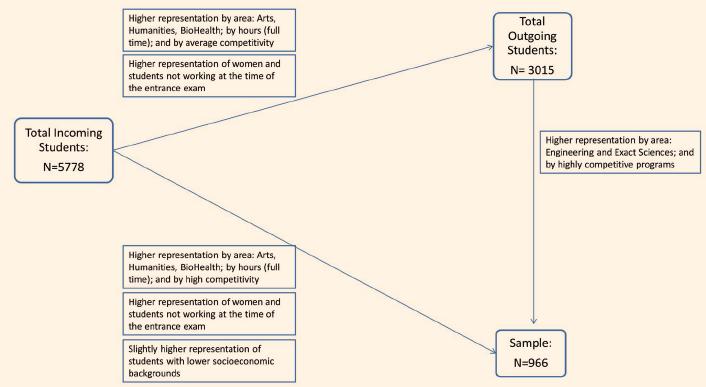
Source: Authors, based on administrative records provided by the institution.
FIGURE 1 MAIN DIFFERENCES BETWEEN THE GROUPS (“INCOMING STUDENTS, “OUTCOMING STUDENTS” AND SAMPLE)
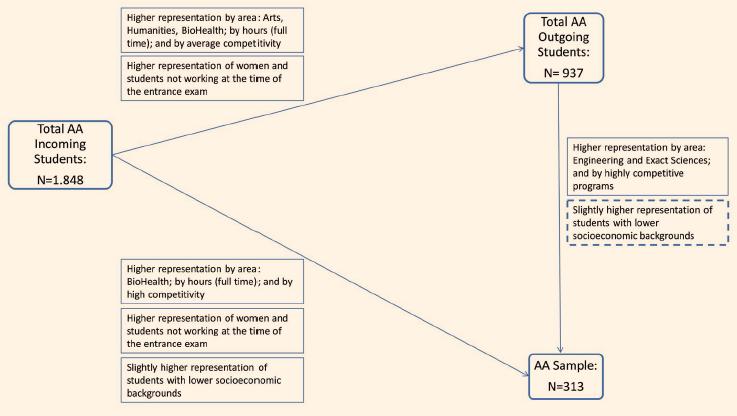
Source: Authors, based on administrative records provided by the institution.
FIGURE 2 MAIN DIFFERENCE BETWEEN THE GROUPS (ONLY AA BENEFICIARIES)
A new electronic questionnaire (T2) was sent out in 2014 to the sample that had agreed to be part of the panel. As soon as the questionnaire was published online, invitations were sent individually to each graduating student that had agreed to participate in the research.8 This made it possible to collect events regarding their professional trajectories up to four and five years after they completed their undergraduate degrees. The structure of the questionnaire included five broad topics: degree obtained from the Institution; situation in the labor market; education investments after graduation; current home situation; and updated contact information. The sample gained from this panel round totaled 575 cases.9
In this way, we can describe at least two work events and characterize: how these jobs were obtained; whether or not there was a job search and how it occurred; and the quality of the jobs (according to their level of satisfaction with regards to work events, the compatibility of these events with their degrees, salaries, and type of contract).10
FROM UNIVERSITY TO THE PROFESSIONAL WORKFORCE
In 2014, four or five years after graduation, no less than 79% of the research participants reported being employed. In addition to the number of jobs obtained between the time of graduation and the survey, what also calls attention is the characteristics of the jobs and how they were obtained (for those who had jobs), and the reasons for not having work (for those who had no professional activity).
The number of jobs obtained in the years since graduation was, on average, only 2.26, which corresponds to 2.33 for the subgroup formed by inclusion beneficiaries (AA) and 2.69 for non-beneficiaries (non-AA), with some residual differences. This result becomes clearer in Figure 3: a distribution notably concentrated to the left, indicating a very low number of job contracts. Therefore, in these first years after graduation, no less than 69% of the trajectories of beneficiaries and 68% of the trajectories of non-beneficiaries are based on only two job contracts.
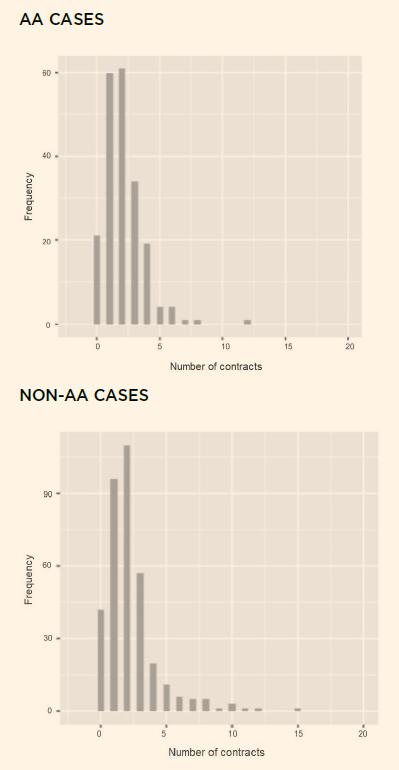
Source: “Panel of graduates”, second wave, June-December of 2014.
FIGURE 3 NUMBER OF WORK CONTRACTS ESTABLISHED BETWEEN GRADUATION AND 2014 BY AFFIRMATIVE ACTION BENEFICIARIES (AA) AND NON-BENEFICIARIES (NON-AA)
The uniqueness of this group’s trajectory is underscored when we observe the time it took to get the job being exercised at the time of the survey. For those working in 2014, the time was almost 2 months (1.7 to be exact), which was slightly higher for the group of Program beneficiaries (AA cases, average of 1.8 months) in comparison to non-beneficiaries (non-AA cases, average of 1.7 months).
The competitivity of the concluded degree seems to make some difference, albeit unexpected. We would expect faster market engagement for those who enrolled in the most competitive programs at the time of the entrance exam and obtained diplomas with higher market value. In fact, the time this group spent getting their current job was slightly inferior vis-à-vis the average (1.69 months). Nevertheless, the time spent by those who obtained degrees from low competitivity programs was much lower (1.2 months), while significantly higher among those who obtained degrees from medium competitivity programs (2.45 months).
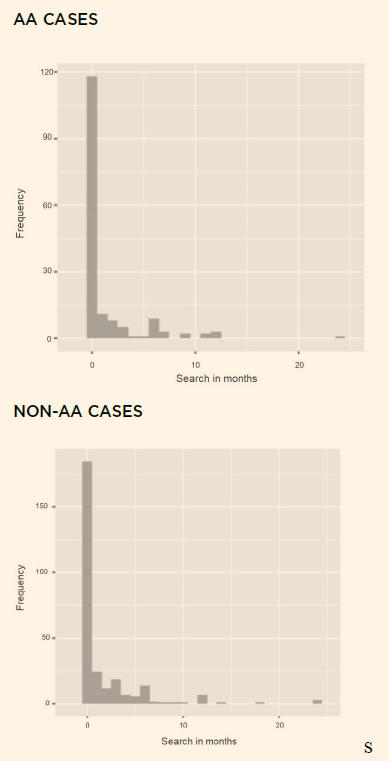
Source: “Panel of graduates”, second wave, June-December of 2014.
FIGURE 4 TIME SPENT SEARCHING FOR CURRENT JOB, FOR AFFIRMATIVE ACTION BENEFICIARIES (AA) AND NON-BENEFICIARIES (NON-AA)
To better understand the enormous gap between the experience of these graduates and the experience of average Brazilian young people, longitudinal data gained from the Monthly Employment Survey [Pesquisa Mensal de Empregos - PME] for the 2003-2013 period (REIS, 2014) reveals that after eight trimesters, or two years, the probability of young people in search of a first job still being unemployed was almost 60% (58% to be exact); for those who had worked before, the probability fell to 38%, while among adults it reached 41%. When extending the period of observation to see what would happen after 20 trimesters, or five years, almost one-third (29% to be exact) of Brazilian young people in search of their first job were still unemployed. Among our graduates, only 10% of them had no work experience in the four to five years after their graduation when the questionnaire was applied.
If we consider the group that had already worked, but that was unemployed in 2014, only 10.3% of them were looking for work. A slightly smaller group (8.6%) were not working because they did not accept the wages they had been offered, showing their high degree of autonomy vis-à-vis the labor market. Even more noteworthy is the fact that the larger group made up of those not working (67.2%) was continuing their education.
More remarkable is the finding that 8 out of every 10 AA beneficiaries had never worked before graduation, a proportion that increases (slightly) to 9 out of 10 among non-beneficiaries of the AA initiative. Undoubtedly, the profile of these individuals is radically different from that of the average Brazilian youth, and which unexpectedly brings inclusion beneficiaries closer to non-beneficiaries.
What is even more interesting is how these graduates found out about the jobs they had access to (Figure 5). Here, non-market mechanisms are by far the most important. Almost half of our graduates found their main source of information within their own relationship networks, whether for their first job (44%) or their job in 2014 (45%). However, it is true that those who did not need affirmative action had relational capital at their disposal that proved more useful in attaining employment, whether it was for their first job (45.6% against 40.5% among beneficiaries), or for their job in 2014 (48.8% among non-beneficiaries and 42.2% among inclusion beneficiaries).
Market mechanisms for employment - such as labor market intermediaries (employment agencies, etc.) or job opportunity announcements - also matter, but much less than private social circuits. Only 20% of the graduates credited intermediary firms for obtaining their first jobs after graduation, and 21.4% for their current jobs. In this case, the difference between affirmative action beneficiaries and non-beneficiaries goes in the opposite direction: beneficiaries need more support from market institutions (23.2% against 20%). This difference becomes marked when we observe the current job: 24.7% of the beneficiaries sought market intermediaries, as opposed to 18.9% of non-beneficiaries.
Job opportunity announcements were less important when compared to networks or even employment agencies, which is valid for both job events. Even so, it is possible to see that this type of access to information is not insignificant, especially (and again) among AA beneficiaries. This is clear, for example, in the comparison between those who access information through announcements and those who seek direct contact with an employer. Non-beneficiaries have greater chances for obtaining a job when they directly contact employers. In terms of a first market engagement, the proportion of affirmative action beneficiaries that got their jobs by anonymous means (such as announcements) is almost three times higher than those who got their jobs by directly contacting employers. On the other hand, the proportion among non-beneficiaries is almost the same (13.4% through announcements and 11.9% through direct contact without an intermediary). Announcements remained more important than making direct contact with employers for the current (2014) jobs among affirmative action beneficiaries. Furthermore, the frequency of turning to announcements (18.7%) is now two times more than making direct contact with an employer (9.6%). The tendency among non-beneficiaries is the same: there is no difference between the proportions of those who use one type of access to information about employment or another (11.9% through announcements and 11.2% through direct contact with an employer).
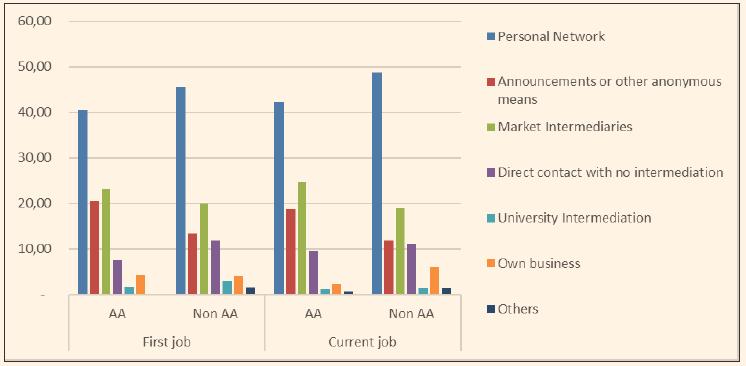
Source: “Panel of graduates”, second wave, June-December of 2014.
FIGURE 5 CHANGES IN TIME, BETWEEN AFFIRMATIVE ACTION BENEFICIARIES (AA) AND NON-BENEFICIARIES (NON-AA), AS TO THE IMPORTANCE OF MECHANISMS FOR ACCESSING EMPLOYMENT INFORMATION IN OBTAINING THE FIRST JOB AFTER GRADUATION AND THE CURRENT JOB (IN %)
Which relational circuits were most effective in providing access to employment? In the case of the first job after graduation, the answer was former classmates. As time went by and they formed professional ties, work colleagues became the main sources for obtaining information that was crucial to recruitment.
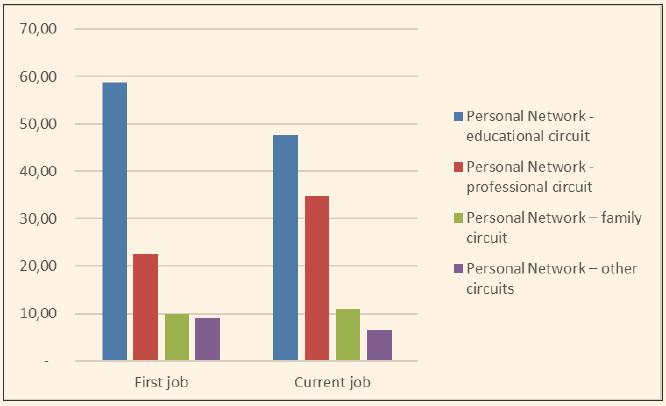
Source: “Panel of graduates”, second wave, June-December of 2014.
FIGURE 6 MOST EFFECTIVE RELATIONAL CONTEXTS THAT PROVIDED ACCESS TO THE FIRST JOB AFTER GRADUATION AND TO THE CURRENT JOB (IN %)
We can see that the educational circuit networks are used as relational capital to boost market engagement chances. The differences observed between AA and non-AA offer clues about non-academic gains obtained from the university experience,11 which are higher among affirmative action beneficiaries.
The educational and professional circuits are the main sources that provide access to information for the both groups. Figure 7 shows how the friendships formed largely during university life become especially relevant when it comes to getting their first job. They continue being important, even after they graduate and are established in the professional market. However, it is among the AA beneficiaries that this importance is particularly noticeable: no less than 64% report finding work by means of this circuit of relations. In both groups, friendships formed during their professional trajectory count less when searching for their first job, most likely because their experience in the market is still limited. Moreover, we have already seen that most of the sample did not work during their undergraduate studies.
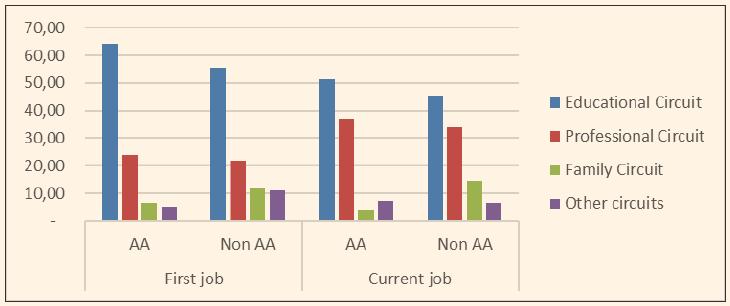
Source: “Panel of graduates”, second wave, June-December of 2014.
FIGURE 7 CONTACTS FOR OBTAINING THE FIRST JOB AFTER GRADUATION AND THE CURRENT JOB, FOR AFFIRMATIVE ACTION BENEFICIARIES (AA) AND NON-BENEFICIARIES (NON-AA) (IN %)
Family members are much more important in terms of providing information among non-beneficiaries and are almost irrelevant in helping beneficiaries find their first job after graduation. The social capital gleaned from family networks becomes more important for those who did not need the support of inclusion policies, even after they became established in the professional market.
In other words, all evidence would suggest that while the affirmative action program - albeit homogenizing by design - allows beneficiaries to enter a prestigious university that provides a competitive education and diploma, it also helps them build a relational circuit that they can actively mobilize as capital in the professional market.
Finally, what can be said about the quality of the employment attained by these graduated? Specific indicators can shed some light on this: the nature of the work contract, the level of protection it offers, the level of remuneration it provides, and the association between the type of employment and the type of degree received.
In terms of the type of employment contract, no less than 83% of the graduates had already obtained formal employment with accompanying rights (CLT* and Statutory) in their first job after graduation. This portion is maintained when observing their situation later in 2014 (Figure 8). This finding renders all other types of contracts as much less significant, almost irrelevant. There is practically no difference between beneficiaries and non-beneficiaries as to the type of contract in their first market engagement after graduation. Later, in 2014, that difference increases slightly (85.5% non-beneficiaries and 89.5% beneficiaries with CLT12 and Statutory).13
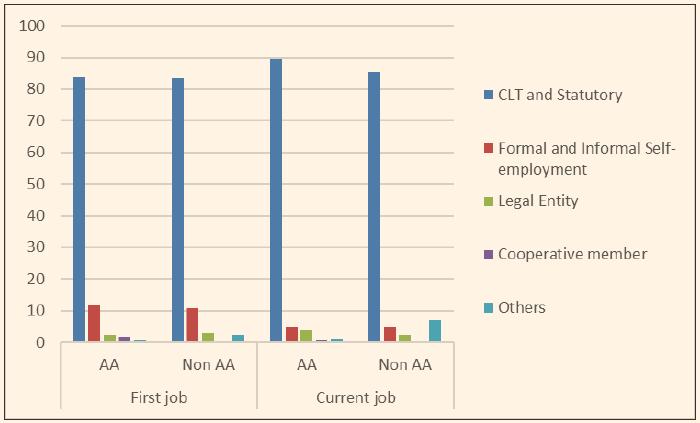
Source: “Panel of graduates”, second wave, June-December of 2014.
FIGURE 8 TYPE OF EMPLOYMENT CONTRACT, FOR AFFIRMATIVE ACTION BENEFICIARIES (AA) AND NON-BENEFICIARIES (NON-AA), IN THE FIRST JOB AFTER GRADUATION AND THE CURRENT JOB (IN %)
If the association between the type of degree and type of professional practice is considered an indicator of the effectiveness of the education received on market inclusion, it appears undisputable among the Institution graduates (Figure 9). This characteristic does not seem to vary in the first years after graduation, even when comparing affirmative action beneficiaries and non-beneficiaries. No less than 77% of the graduates worked in an area related to their degree, which continued for 75.4% of the graduates in their current work.
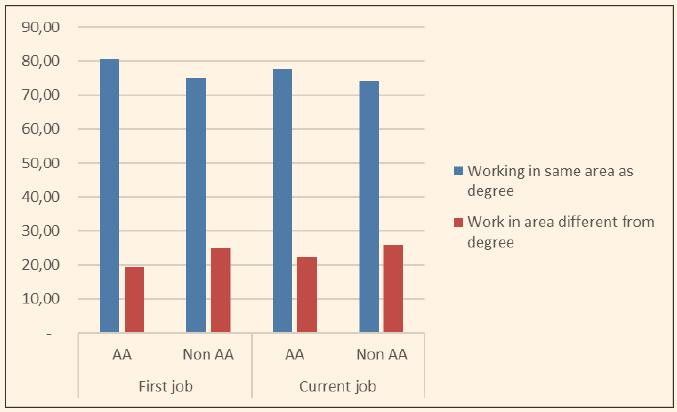
Source: “Panel of graduates”, second wave, June-December of 2014.
FIGURE 9 RELATION BETWEEN DEGREE AND AREA OF PROFESSIONAL WORK, FOR AFFIRMATIVE ACTION BENEFICIARIES (AA) AND NON-BENEFICIARIES (NON-AA), IN THE FIRST JOB AFTER GRADUATION AND IN THE CURRENT JOB (IN %)
Could it be that the socioeconomic homogeneity observed in the beginning is expressing itself as homogeneity in the employment attained with the diploma? To answer this question, we observed the highest salary associated to this prestigious credential in each of the employment events in order to locate the main differences. Two associated results can lead to implications. On one hand, the levels of remuneration tend to increase with experience in the professional world (which is expected, in principle). On the other hand, wage returns associated to holding a prestigious diploma are different between beneficiaries and non-beneficiaries, despite the significant social homogeneity that was produced at the starting point, which reflects the way the institution shaped its AA initiative,
Figure 10 shows what happens with incomes that correspond to ten minimum wages (approximately US$ 1,940 in 2014) or higher. Although not very expressive early on in their careers for either group, this type of income was more frequent for non-beneficiaries. As they gain professional experience, the portion of graduates earning higher wages naturally increases, although there is still a gap that favors non-beneficiaries. The intermediate income group earning 5 to 10 minimum wages does not show changes over time that are significant enough to create differences between the two groups in 2014. However, the two lowest income groups (up to five minimum wages) experience the most important changes over time: although the cases diminish, a significant portion of professionals that benefitted from the AA program continue earning between 2 and 5 minimum wages, even after a reasonable time of professional experience.
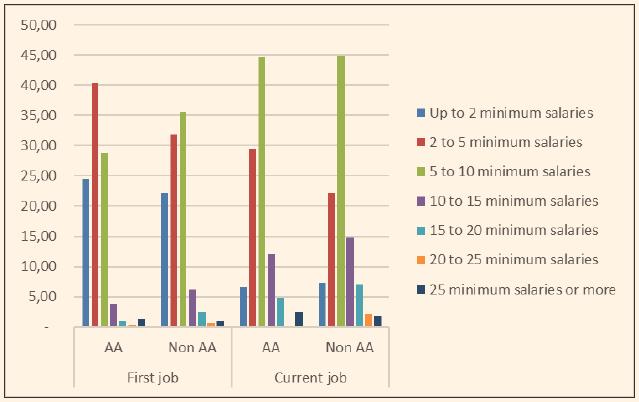
Source: “Panel of graduates”, second wave, June-December of 2014.
FIGURE 10 REMUNERATION FROM FIRST JOB AFTER GRADUATION AND THE CURRENT JOB, BY SALARY LEVELS, FOR AFFIRMATIVE ACTION BENEFICIARIES (AA) AND NON-BENEFICIARIES (NON-AA) (IN %)
Other sources of income variations can be equally explored. In Figure 11, we show the effect of the type of academic degree, classified according to its level of competitivity. We supposed that a highly demanded program with more competitive entrance exams would be more likely to provide access to higher quality and better paid jobs. In fact, the less competitive programs present the opposite pattern when observing their frequency in low and average wages.
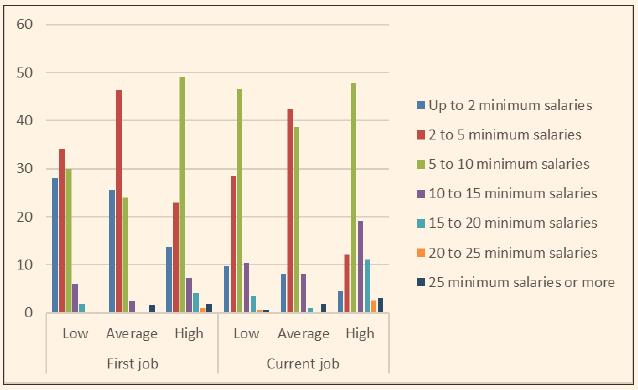
Source: “Panel of graduates”, second wave, June-December of 2014.
FIGURE 11 REMUNERATION FROM FIRST JOB AFTER GRADUATION AND THE CURRENT JOB, BY SALARY RANGE, ACCORDING TO THE LEVEL OF COMPETITIVITY OF THE ACADEMIC DEGREE OBTAINED (IN %)
Gender differences were also associated to wage levels, as shown in Figure 12. The proportion of women in lower income ranges is more significant that the proportion of men. Furthermore, there are more men in higher income ranges, which is a tendency that increases in the 2014 jobs. The proportion of men in the ten minimum salaries or higher range at the time of their first job (12.4%) was double that of women (6.4%). This difference is accentuated in 2014 when these proportions increase to 31.1% and 13.6% respectively. This wage distribution is unequal even in the lower income ranges. More women are found in the first two ranges (up to five minimum salaries) for both work events. In their first job, 64.8% of the women received up to five minimum wages, as opposed to 44.2% of the men. In their 2014 job, 43.2% of the women still remained in that same salary range, in contrast to 22.2% of the men.
FINAL REMARKS
Extensive literature has underscored the complexity (from the life course theoretical perspective) and heterogeneity (from the perspective of social conditions) involved in transitioning from education to the labor market (ROSENBAUM et al., 1990; SHAVIT; BLOSSFELD, 1993; SHAVIT; MÜLLER, 1998; DUBAR, 1998; SALAS-VELASCO, 2007; NEWMAN, 2009). In this respect, many authors have also showed important singularities in the Brazilian case (PASTORE; SILVA, 2000; HASENBALG, 2003; CAMARANO, 2006; GUIMARÃES, 2006; COMIN; BARBOSA, 2011; MARTELETO; SOUZA, 2013; CORSEUIL; BOTELHO, 2014). Evidently, here is not the place for an exhaustive review of this literature. However, it is certainly necessary to keep it in mind so that we do not lose sight of the unique aspects of the cases tracked in this panel.
We begin our analysis from the standpoint of a key idea: the way the observed institution constructed its Affirmative Action Program had an inescapable effect not only on the profile of the students recruited for this initiative, as indicated by Brito (2014), but also in the patterns exhibited by the graduates when they enter the workforce. This marker is grounded in how the bonus system was applied to the first two cohorts of enrolled students after the Affirmative Action Program was created. The way the bonus was created and implemented in 2005 and 2006 meant that it benefitted candidates from public schools and/or those who self-identified as “black,” “mixed race,” or “indigenous” only if they survived the first phases of the selection process on their own, without any positive discrimination. So, because the Program did not affect the first phase, the socioeconomic homogeneity of the candidates that passed to the second phase was notable. In this sense, the inclusion policy only entered the scene after the effects of the socioeconomic selection had been felt.
However, this should not lead us to conclude that the Program lacked impact. Brito (2014) showed that the bonus significantly increases admission chances in the second phase for candidates who fit the beneficiary profile, especially in the more competitive university degree programs. His study showed, for example, that the Program multiplied the chances for a potential beneficiary to be approved in the Medicine program by almost six times in 2005; and by four times in 2006. However, it is also true that it increased the chances of individuals that were already much more prepared due to their socioeconomic pre-conditions, given the nature of the selection operated in the first phase of the exam that freely and simultaneously applied filters of knowledge accumulated during secondary school and from socioeconomic origins.
This institutional mechanism makes the movements of these young people very specific when entering the professional market; a movement that is likewise characteristic of a minority, as per the still small number of young people with higher education degrees in the Brazilian labor force.14 According to PNAD, although the number of those who completed higher education tripled between 1995 and 2012 among young Brazilians aged between 25 and 29,15 university graduates still made up only 14% of that age group in 2012 (COSTA; OLIVEIRA, 2014), the same period during which we tracked our sample. It is worth stating that tracking the trajectories of young people who completed higher education means tracking the occupational destinations of a restricted number of Brazilian young people. Even more so if they come from socioeconomic groups that are relatively privileged, as is the case of our analysis.
This distinguishing feature of the subpopulation observed in this study can be analytically beneficial for reflecting on the process of professional engagement experienced by individuals who have the kind of family capital, schooling, and relational networks that make them especially competitive and that can add potential to a high market value diploma. They form a counter-case in a limit situation that has until now been somewhat overlooked by our literature, and which can enlighten other studies about youth trajectories and transitions in Brazil’s labor market.
However, the specificities of this elite group also help us think about how inequalities in trajectories can be associated to differentiations (even if limited) in schooling and family origins. Such differentiations allow us a better understanding of those who need the bonus as a strategy for getting into a competitive and socioeconomically select school. Moreover, our results show how the relational networks created during university life were as important to the professional reach of inclusion program beneficiaries as the highly recognized diploma they attained through the Affirmative Action Program.
In summary, this diploma has undisputable value, both because of the salary returns it brings, and, more broadly, because of the high-quality professional inclusion it produces. The quality of inclusion can be measured by the type of contract, the speed at which it is attained, the association between employment and the academic degree obtained, and by the level of satisfaction with the professional integration achieved. From a non-market and non-academic perspective, the experience at the institution exposes the recruited students to contacts that become of great value, and that they resort to for seemingly a long time, not only for help in entering the market. It is worth saying that these contacts effectively help them enter and circulate the professional workforce.
Even though the institutional design of the bonus policy limits the effects of differentiating recruits by to socioeconomic origins, differences still remain between beneficiaries and non-beneficiaries when it comes to professional integration. Not only in how they attain employment, but also in the results of their engagement, especially in terms of salary returns. Thus, Program beneficiaries are found more frequently in lower income ranges, and the same can be observed of blacks and mixed-race groups. However, it is also true that there are other sources of salary differences, such as the high number of women in the lowest income levels.
In summary, although a prestigious diploma transforms the quality of the trajectories of those who hold it and frees them from the vicissitudes that affect the majority of young Brazilians, it cannot fully elude the differences, even if few, that continue to separate those who use affirmative actions to enter a highly competitive institution. Proof of this is found in the salary inequalities that reappear in the first few years of their professional careers.











 texto en
texto en 


